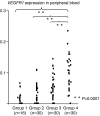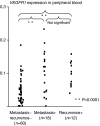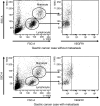Identification of the high-risk group for metastasis of gastric cancer cases by vascular endothelial growth factor receptor-1 overexpression in peripheral blood
- PMID: 17486129
- PMCID: PMC2359929
- DOI: 10.1038/sj.bjc.6603785
Identification of the high-risk group for metastasis of gastric cancer cases by vascular endothelial growth factor receptor-1 overexpression in peripheral blood
Abstract
Identification of an isolated tumour cell with metastatic ability is important for predicting the recurrence and prognosis of gastric cancer. A biological marker for evaluating the metastatic ability of gastric cancer cells has not yet been identified. We assessed vascular endothelial growth factor receptor-1 mRNA expression by quantitative real-time reverse transcriptase-polymerase chain reaction. Vascular endothelial growth factor receptor-1 mRNA in peripheral blood was more highly expressed in perioperative metastasis-positive and postoperative recurrence cases than in normal control cases, early cancer cases and nonmetastatic advanced cancer cases. The peripheral blood vascular endothelial growth factor receptor-1 mRNA-positive group was associated with advanced clinical stage, deep invasion beyond the muscularis propria, lymphatic involvement, vascular involvement, lymph node metastasis, positive peritoneal lavage cytology, preoperative metastasis and postoperative recurrence. Flow cytometry analysis disclosed that vascular endothelial growth factor receptor-1 expressing cells in the peripheral blood were more abundant in cancer cases with metastases than in cases without metastases. Our data suggest that the amount of positive cells may provide information on the clinical features of gastric cancer, especially in regard to gastric cancer metastasis.
Figures



Similar articles
-
A large-scale study of MT1-MMP as a marker for isolated tumor cells in peripheral blood and bone marrow in gastric cancer cases.Ann Surg Oncol. 2008 Oct;15(10):2934-42. doi: 10.1245/s10434-008-9916-z. Epub 2008 Jul 26. Ann Surg Oncol. 2008. PMID: 18661187 Clinical Trial.
-
Detection of circulating gastric cancer cells in peripheral blood using real time quantitative RT-PCR.Hepatogastroenterology. 2008 May-Jun;55(84):1131-5. Hepatogastroenterology. 2008. PMID: 18705345
-
Hematogenous metastasis in gastric cancer requires isolated tumor cells and expression of vascular endothelial growth factor receptor-1.Clin Cancer Res. 2008 May 1;14(9):2609-16. doi: 10.1158/1078-0432.CCR-07-4354. Clin Cancer Res. 2008. PMID: 18451223
-
[Circulating tumour cells is a promising prognostic and predictive marker of gastric cancer].Ugeskr Laeger. 2014 Aug 4;176(32):1490-3. Ugeskr Laeger. 2014. PMID: 25292471 Review. Danish.
-
Micrometastasis in gastric cancer.Cancer Lett. 2013 Aug 9;336(1):34-45. doi: 10.1016/j.canlet.2013.04.021. Epub 2013 Apr 23. Cancer Lett. 2013. PMID: 23624301 Review.
Cited by
-
A novel kinase mutation in VEGFR-1 predisposes its αC-helix/activation loop towards allosteric activation: Atomic insights from protein simulation.Eur J Hum Genet. 2016 Aug;24(9):1287-93. doi: 10.1038/ejhg.2016.26. Epub 2016 Apr 6. Eur J Hum Genet. 2016. PMID: 27049304 Free PMC article.
-
Radiolabeling and evaluation of (64)Cu-DOTA-F56 peptide targeting vascular endothelial growth factor receptor 1 in the molecular imaging of gastric cancer.Am J Cancer Res. 2015 Oct 15;5(11):3301-10. eCollection 2015. Am J Cancer Res. 2015. PMID: 26807312 Free PMC article.
-
125I-F56 Peptide as Radioanalysis Agent Targeting VEGFR1 in Mice Xenografted with Human Gastric Tumor.ACS Med Chem Lett. 2017 Jan 20;8(2):266-269. doi: 10.1021/acsmedchemlett.6b00498. eCollection 2017 Feb 9. ACS Med Chem Lett. 2017. PMID: 28197324 Free PMC article.
-
Vascular endothelial growth receptor 1 acts as a stress-associated protein in the therapeutic response to thalidomide.Exp Ther Med. 2017 Nov;14(5):4263-4271. doi: 10.3892/etm.2017.5028. Epub 2017 Aug 24. Exp Ther Med. 2017. PMID: 29075340 Free PMC article.
-
VEGF, Flt-1, and microvessel density in primary tumors as predictive factors of colorectal cancer prognosis.Mol Clin Oncol. 2017 Feb;6(2):243-248. doi: 10.3892/mco.2016.1121. Epub 2016 Dec 30. Mol Clin Oncol. 2017. PMID: 28357103 Free PMC article.
References
-
- Beerepoot LV, Mehra N, Vermaat JS, Zonnenberg BA, Gebbink MF, Voest EE (2004) Increased levels of viable circulating endothelial cells are an indicator of progressive disease in cancer patients. Ann Oncol 15: 139–145 - PubMed
-
- Clark DE, Smith SK, He Y, Day KA, Licence DR, Corps AN, Lammoglia R, Charnock-Jones DS (1998) A vascular endothelial growth factor antagonist is produced by the human placenta and released into the maternal circulation. Biol Reprod 59: 1540–1548 - PubMed
-
- Fan F, Wey JS, McCarty MF, Belcheva A, Liu W, Bauer TW, Somcio RJ, Wu Y, Hooper A, Hicklin DJ, Ellis LM (2005) Expression and function of vascular endothelial growth factor receptor-1 on human colorectal cancer cells. Oncogene 24: 2647–2653 - PubMed
-
- Ferrara N, Davis-Smyth T (1997) The biology of vascular endothelial growth factor. Endocr Rev 18: 4–25 - PubMed
-
- Galland F, Karamysheva A, Pebusque MJ, Borg JP, Rottapel R, Dubreuil P, Rosnet O, Birnbaum D (1993) The FLT4 gene encodes a transmembrane tyrosine kinase related to the vascular endothelial growth factor receptor. Oncogene 8: 1233–1240 - PubMed
Publication types
MeSH terms
Substances
LinkOut - more resources
Full Text Sources
Medical

